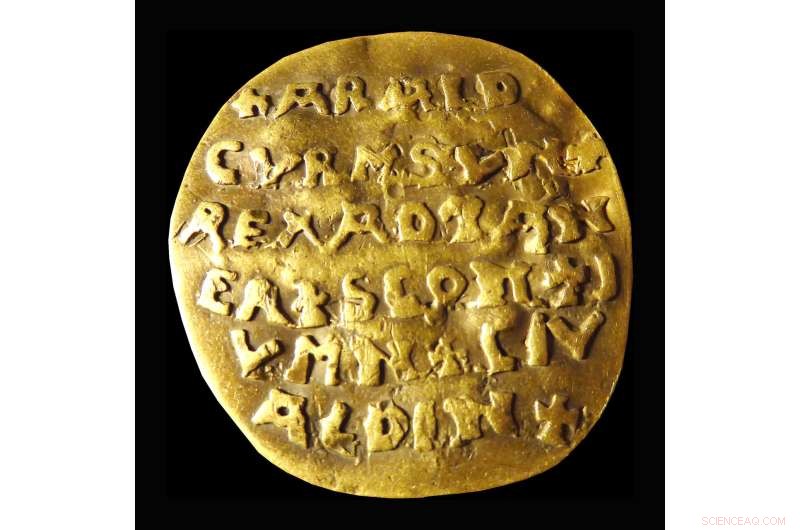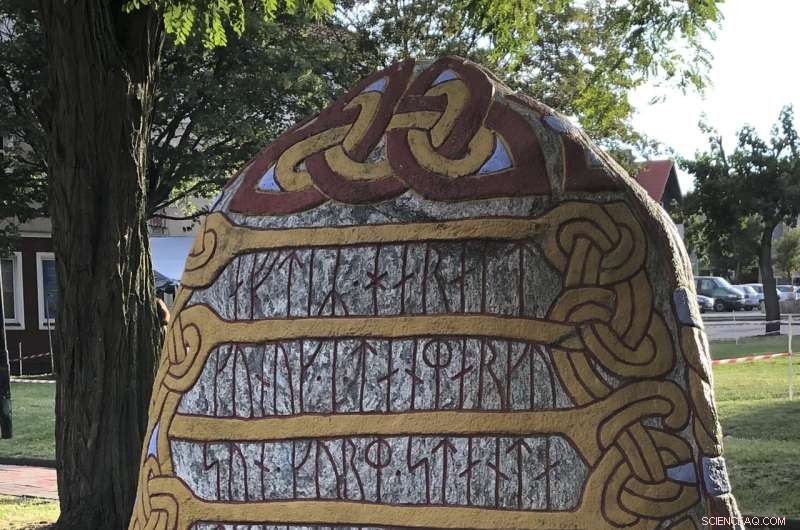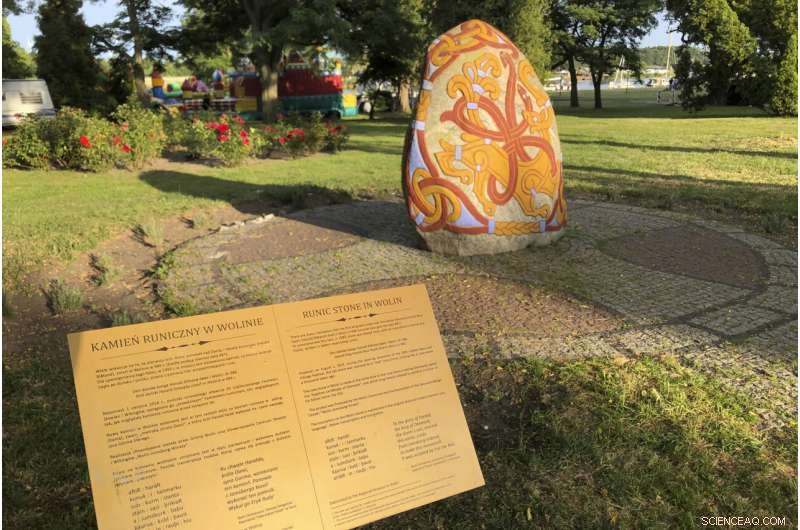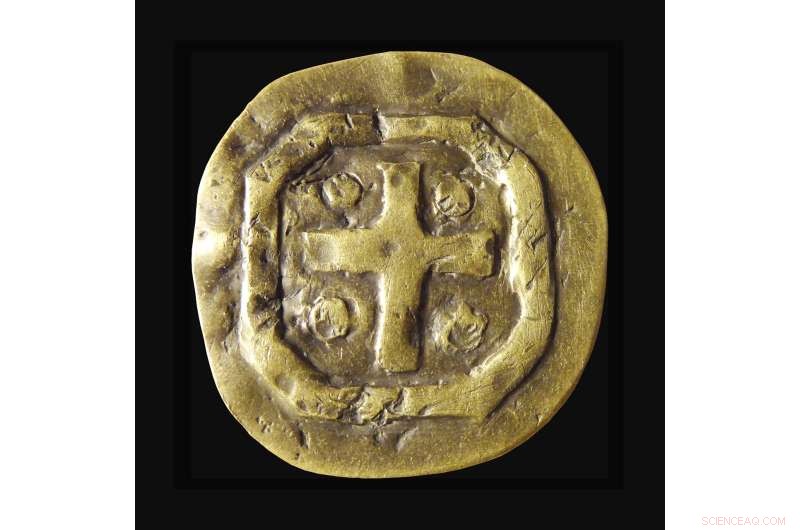
Den gyllene Curmsun-skivan från 1000-talet med namnet på den danske kungen Harald "Bluetooth" Gormsson (Curmsun på latin), som kommer från en grav vid den romersk-katolska kyrkan i Wiejkowo, Polen, fotograferad i Malmö, Sverige, 2015. Blåtand trådlös länkteknik är uppkallad efter kungen. Mer än 1 000 år efter hans död i det som nu är Polen, är en dansk kung vars smeknamn är känt för världen genom Bluetooth-tekniken i centrum för en arkeologisk tvist. Kredit:Sven Rosborn via AP
Mer än 1 000 år efter hans död i det som nu är Polen, är en europeisk kung vars smeknamn lever vidare genom trådlös teknik i centrum för en arkeologisk tvist.
Krönikor från medeltiden säger att kung Harald "Bluetooth" Gormsson av Danmark fick sitt smeknamn med tillstånd av en tand, förmodligen död, som såg blåaktig ut. En krönika från den tiden säger också att vikingakungen begravdes i Roskilde i Danmark i slutet av 1000-talet.
Men en svensk arkeolog och en polsk forskare hävdade nyligen i separata publikationer att de har pekat ut hans mest troliga gravplats i byn Wiejkowo, i ett område i nordvästra Polen som hade band till vikingarna på Haralds tid.
Marek Kryda, författare till boken "Viking Poland", berättade för The Associated Press att en "hednisk hög" som han hävdar att han har lokaliserat under Wiejkowos romersk-katolska kyrka från 1800-talet förmodligen håller kungens kvarlevor. Kryda sa att geologiska satellitbilder tillgängliga på en polsk regeringsportal avslöjade en rund form som såg ut som en vikingagravhög.
Men svenske arkeologen Sven Rosborn, säger att Kryda har fel eftersom Harald, som konverterade från hedendom till kristendom och grundade kyrkor i området, måste ha fått en lämplig grav någonstans på kyrkogården. Wiejkowo's Church of the Immaculate Conception of the Blessed Virgin Mary står på toppen av en liten rund kulle.

En vy av en sten från 2014 med runinskription till minne av danska 1000-talets kung Harald "Bluetooth" Gormsson, i Wolin, Polen, lördagen den 30 juli 2022. Mer än 1 000 år efter hans död i det som nu är Polen, är en dansk kung vars smeknamn är känt för världen genom Bluetooth-tekniken i centrum för en arkeologisk tvist. En polsk forskare och en svensk arkeolog hävdar att de har pekat ut den troliga gravplatsen för kung Harald Blåtand Gormsson i en liten by i nordvästra Polen, ett område som en gång hade band med vikingarna. Kredit:AP Photo Monika Scislowska
Historiker vid det danska nationalmuseet i Köpenhamn säger att de känner till "förslaget" att Wiejkowo är Haralds gravplats.
Rosborn detailed his research in the 2021 book "The Viking King's Golden Treasure" and Kryda challenged some of the Swede's findings in his own book published this year.
Harald, who died in 985, probably in Jomsborg—which is believed to be the Polish town of Wolin now—was one of the last Viking kings to rule over what is now Denmark, northern Germany, and parts of Sweden and Norway. He spread Christianity in his kingdom.
Swedish telecommunications company Ericsson named its Bluetooth wireless link technology after the king, reflecting how he united much of Scandinavia during his lifetime. The logo for the technology is designed from the Scandinavian runic letters for the king's initials, HB.

A view of a 2014 stone with runic inscription in memory of Danish 10th century King Harald “Bluetooth” Gormsson, in Wolin, Poland, Saturday, July 30,2022. More than 1,000 years after his death in what is now Poland, a Danish king whose nickname is known to the world through the Bluetooth technology is at the center of an archeological dispute. A Polish researcher and a Swedish archeologist claim that they have pinpointed the probable burial site for King Harald Bluetooth Gormsson in a small village in northwestern Poland, an area that once had ties with the Vikings. Credit:AP Photo Monika Scislowska
Rosborn, the former director of Sweden's Malmo City Museum, was spurred on his quest in 2014 when an 11-year-old girl sought his opinion about a small, soiled coin-like object with old-looking text that had been in her family's possession for decades.
Experts have determined that the cast gold disk that sparked Maja Sielski's curiosity dated from the 10th century. The Latin inscription on what is now known as the "Curmsun disk" says:"Harald Gormsson (Curmsun in Latin) king of Danes, Scania, Jomsborg, town Aldinburg."
Sielski's family, who moved to Sweden from Poland in 1986, said the disk came from a trove found in 1841 in a tomb underneath the Wiejkowo church, which replaced a medieval chapel.
The Sielski family came into the possession of the disk, along with the Wiejkowo parish archives that contained medieval parchment chronicles in Latin, in 1945 as the former German area was becoming part of Poland as a result of World War II.

The Roman Catholic church where it is believed that Danish King Harald Gormsson was buried, in Wiejkowo, Poland, Saturday, July 30, 2022. More than 1,000 years after his death in what is now Poland, a Danish king whose nickname is known to the world through the Bluetooth technology is at the center of an archeological dispute. A Polish researcher and a Swedish archeologist claim that they have pinpointed the probable burial site for King Harald Bluetooth Gormsson in a small village in northwestern Poland, an area that once had ties with the Vikings. Credit:AP Photo Monika Scislowska

A view inside the Roman Catholic church where it is believed that Danish King Harald Gormsson was buried, in Wiejkowo, Poland, Saturday, July 30, 2022. More than 1,000 years after his death in what is now Poland, a Danish king whose nickname is known to the world through the Bluetooth technology is at the center of an archeological dispute. A Polish researcher and a Swedish archeologist claim that they have pinpointed the probable burial site for King Harald Bluetooth Gormsson in a small village in northwestern Poland, an area that once had ties with the Vikings. Credit:AP Photo Monika Scislowska

The 10th century golden Curmsun disc with the name of Danish King Harald “Bluetooth“ Gormsson (Curmsun in Latin) on it, coming from a tomb at the Roman Catholic church in Wiejkowo, Poland, photographed in Malmo, Sweden, in 2015. The Bluetooth wireless link technology is named after the king. More than 1,000 years after his death in what is now Poland, a Danish king whose nickname is known to the world through the Bluetooth technology is at the center of an archeological dispute. Credit:Sven Rosborn via AP
A family member who knew Latin understood the value of the chronicles—which dated as far back as the 10th century—and translated some of them into Polish. They mention Harald, another fact linking the Wiejkowo church to him.
The nearby Baltic Sea island and town of Wolin cultivates the region's Viking history:it has a runic stone in honor of Harald Bluetooth and holds annual festivals of Slavs and Vikings.
Kryda says the Curmsun disk is "phenomenal" with its meaningful inscription and insists that it would be worth it to examine Wiejkowo as Harald's burial place, but there are no current plans for any excavations. + Utforska vidare
© 2022 Associated Press. Alla rättigheter förbehållna. Detta material får inte publiceras, sändas, skrivas om eller omdistribueras utan tillstånd.